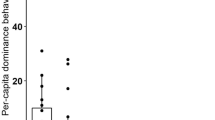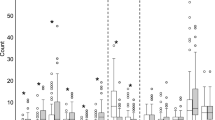Summary
Intracolony aggression among workers of the neotropical ponerine ant species Pachycondyla apicalis leads to dominance orders. Antagonistic interactions can entail either overt physical attacks with the subordinate individual often exhibiting a submissive posture or the robbing and destruction of eggs laid by nestmates. The single queen, however, was never observed either attacking or being attacked by any colony member. The hierarchical structure among workers consists of one dominant individual and several subordinates; the relationships among subordinate workers are unclear, however. We report for the first time a natural (nonmanipulated) change in the social status of individuals within an ant dominance order. Dominant workers usually had better developed ovaries, laid more eggs and were more frequently observed attending the egg pile than subordinate individuals. This pattern became even more striking when the queen was excluded from the colony. These results indicate that workers of P. apicalis lay eggs even in the presence of the queen. It is possible that some of these haploid eggs may develop into males.
Similar content being viewed by others
References
Appleby MC (1983) The probability of linearity in hierarchies. Anim Behav 31:600–608
Bhatkar A, Whitcomb WH (1970) Artificial diet for rearing various species of ants. Fla Entomol 53:229–232
Bourke AFG (1988a) Dominance orders, worker reproduction, and queen-worker conflict in the slave-making ant Harpagoxenus sublaevis. Behav Ecol Sociobiol 23:323–333
Bourke AFG (1988b) Worker reproduction in the higher eusocial Hymenoptera. Q Rev Biol 63:291–311
Choe JC (1988) Worker reproduction and social evolution in ants (Hymenoptera: Formicidae). In: Trager JC (ed) Advances in myrmecology. EJ Brill, Leiden, pp 163–187
Cole BJ (1981) Dominance hierarchies in Leptothorax ants. Science 212:83–84
Dewsbury DA (1982) Dominance rank, copulatory behavior and differential reproduction. Q Rev Biol 57:135–159
Evesham EJM (1984) Queen distribution movements and interactions in a semi-natural nest of the ant Myrmica rubra L. Insectes Soc 31:5–19
Fletcher DJC, Ross KG (1985) Regulation of reproduction in eusocial Hymenoptera. Annu Rev Entomol 30:319–343
Fowler HG, Roberts RB (1983) Anomalous social dominance among queens of Camponotus ferrugineus (Hymenoptera: Formicidae). J Nat Hist 17:185–187
Franks NR, Scovell E (1983) Dominance and reproductive success among slave-making worker ants. Nature 304:724–725
Fesneau D (1984) Déveoppement ovarien et status sociale chez une fourmi primitive Neoponera obscuricornis Emery (Hym. Formicidae, Ponerinae). Insectes Soc 31:387–402
Fresneau D, Dupuy P (1988) A study of polyethism in a ponerine ant: Neoponera apicalis (Hympenoptera, Formicidae). Anim Behav 36:1389–1399
Fukumoto Y, Abe T, Taki A (1989) A novel form of colony organization in the “queenless” ant Diacamma rugosum. Physiol Ecol Jpn 26:55–61
Heinze J, Smith TA (1990) Dominance and fertility in a functionally monogynous ant. Behav Ecol Sociobiol 27:1–10
Hölldobler B, Bartz SH (1985) Sociobiology of reproduction in ants. In: Hölldobler B, Lindauer M (eds) Experimental behavioral ecology and Sociobiology. G Fischer, New York Stuttgart, pp 237–257
Hölldobler B, Carlin NF (1985) Colony founding, queen dominance and oligogyny in the Australian meat ant Iridomyrmex purpureus. Behav Ecol Sociobiol 18:45–58
Hölldobler B, Taylor RW (1983) A behavioral study of the primitive ant Nothomyrmecia macrops Clark. Insectes Soc 30:384–401
Pardi L (1946) Richerche sui Polistine. VII. La “dominazione” e il ciclo ovarico annuale in Polistes gallicus (L.). Boll Ist Ent Univ Bologna 15:25–84
Pardi L (1948) Dominance order in Polistes wasps. Physiol Zool 21:1–13
Peeters CP (1987) The reproductive division of labour in the queenless ponerine ant Rhytidoponera sp. 12. Insectes Soc 34:75–86
Peeters C, Higashi S (1989) Reproductive dominance controlled by mutilation in the queenless ant Diacamma australe. Naturwissenschaften 76:177–180
Ratnieks FLW, Visscher PK (1989) Worker policing in the honeybee. Nature 342:796–797
Röseler PF (1985) Endocrine basis of dominance and reproduction in polistine paper wasps. Fortschr Zool 31:259–272
West-Eberhard MJ (1969) The social biology of polistine wasps. Mise Publs Mus Zool Univ Mich 140:1–101
Wheeler DE (1986) Developmental and physiological determinants of caste in social Hymenoptera: evolutionary implications. Am Nat 128:13–34
Wilson EO (1971) The insect societies. Belknap, Cambridge, MA
Wilson EO (1974) Aversive behavior and competition within colonies of the ant Leptothorax curvispinosus. Ann Entomol Soc Am 67:777–780
Wilson EO (1975a) Sociobiology: the new synthesis. Belknap, Cambridge, MA
Wilson EO (1975b) Leptothorax duloticus and the beginnings of slavery in ants. Evolution 29:108–119
Wilson EO, Brown WL, Jr (1984) Behavior of the cryptobiotic predaceous ant Eurhopalothrix heliscata, N. Sp. (Hymenoptera: Formicidae: Basicerotini). Insectes Soc 31:408–428
Author information
Authors and Affiliations
Additional information
Offprint requests to: B. Holldobler
Rights and permissions
About this article
Cite this article
Oliveira, P.S., Holldobler, B. Dominance orders in the ponerine ant Pachycondyla apicalis (Hymenoptera, Formicidae). Behav Ecol Sociobiol 27, 385–393 (1990). https://doi.org/10.1007/BF00164064
Received:
Accepted:
Issue Date:
DOI: https://doi.org/10.1007/BF00164064




